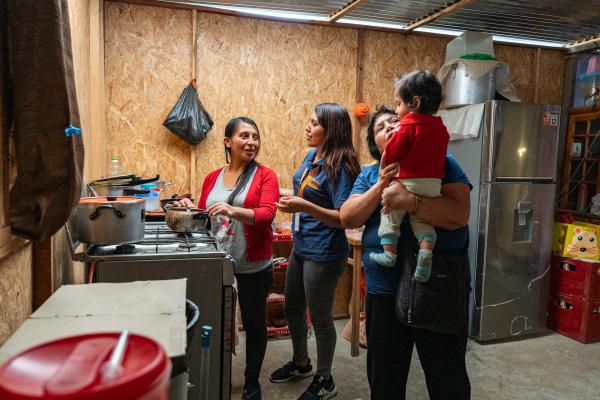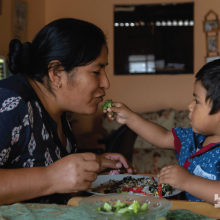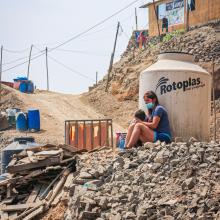In Peru, anemia is a public health problem. In 2023, it affected 43.1% of girls and boys aged 6 to 35 months, according to the National Institute of Statistics and Informatics (INEI). An increase of 1.2%, compared to last year, which has led health authorities to propose new solutions to put a stop to this condition.
“We must look at anemia as a multi-causal problem,” says Karen Ramos, head of the Maternal, Infant and Adolescent Health Program (SAMIA), of Socios En Salud.
In this line, the Ministry of Health (MINSA) has published last April its “Multisectoral Plan for the prevention and reduction of maternal and child anemia in the period 2024-2030”, which brings together various actions to reduce the prevalence of this health problem to 37.2 % in girls and boys, with emphasis on children under 36 months of age and pregnant women.
In addition, it has approved two technical standards that highlight the role of “social actors”. One of them raises “guidelines for the implementation of home visits” to promote child development, while the other picks up the value of face-to-face appointments and teleconferences in the prevention of anemia.
This is a work that Socios En Salud has been strengthening for years through its community agents. Proof of this is Ally Wambra 2.0, the second version of a SAMIA educational intervention that, through community accompaniment, seeks to reduce anemia in children aged 6 to 12 months in Carabayllo.
Rolling and follow-up, two key stages
At only eight months old, little Marvin underwent a hemoglobin dosage at the Su Majestad Hiroito Health Center in Carabayllo. His results, lower than the 11g/dL recommended by the World Health Organization (WHO), worried his mother, Elva Calle.
It was then that, as part of her active search, the Ally Wambra 2.0 team, thanks to its partnership with the Directorate of Integrated Health Networks (Diris) Lima Norte, contacted her and visited her home. Thus, in November 2023, Marvin joined the 60 children who were enrolled in this second version of the SAMIA initiative.
“They have helped me a lot,” Calle acknowledges. “I learned a lot with their recipes and with the support, the motivation, and the odd bit of advice.”
Currently, Marvin’s mother is grateful to Inela Espinoza, a Socios En Salud community agent with more than 20 years of experience who was assigned to follow her baby during anemia treatment.
According to nutritionist Andrea Flores, an assistant at Ally Wambra 2.0, this regimen includes two points: first, the consumption of iron supplements; second, the intake of foods high in iron through responsive feeding, a strategy that consists of offering a variety of healthy foods in portions appropriate for the age of each child.
“The home visits of the community agents ensure both points: the follow-up of the supplementation, even if adverse effects are shown, and the responsive feeding that the mother provides to the children,” she says.
Before establishing contact with mothers or caregivers, Espinoza received training in anemia prevention and recovery, and in the use of the mobile application “Yo Promotor”, which allows her to record relevant information during her monitoring.
“The work I do is complete, because I not only focus on anemia, but I live the reality of the mothers. We end up being counselors many times. One goes with the mission of guiding in responsive feeding, but in a home without resources, you work with what you have,” she says.
Along with a team of nutritionists, the community agents guide the mothers or caregivers to take advantage of the supplies they can access and prepare nutritious and tasty recipes that raise the iron levels in the babies’ blood.
“We promote the little blood, the liver, and if there is a refusal on the part of the children to eat it, we recommend mixing it with sweet potato, which is sweet, or adding it to a mango mousse, for example, which has greatly facilitated the consumption of these foods,” says Espinoza.
Some preliminary results
“Cultural beliefs” often play a role in why mothers or caregivers of children decide to abandon anemia treatment, says Karen Ramos. “They believe that only with food can overcome (the problem),” she says.
However, Ally Wambra 2.0 has been demonstrating that accompaniment is necessary as an essential piece in the fight against this health problem, which can have irreversible consequences on a child’s psychomotor development.
“We need people who know about the issue, leading community agents who can contact moms and accompany them during treatment so that they don’t abandon it,” says Ramos.
This has been appreciated by mothers like Elva Calle, whose baby has recovered from anemia, and also by the health authorities, who have been implementing home visits and teleconferences in their action plans to prevent this condition.



